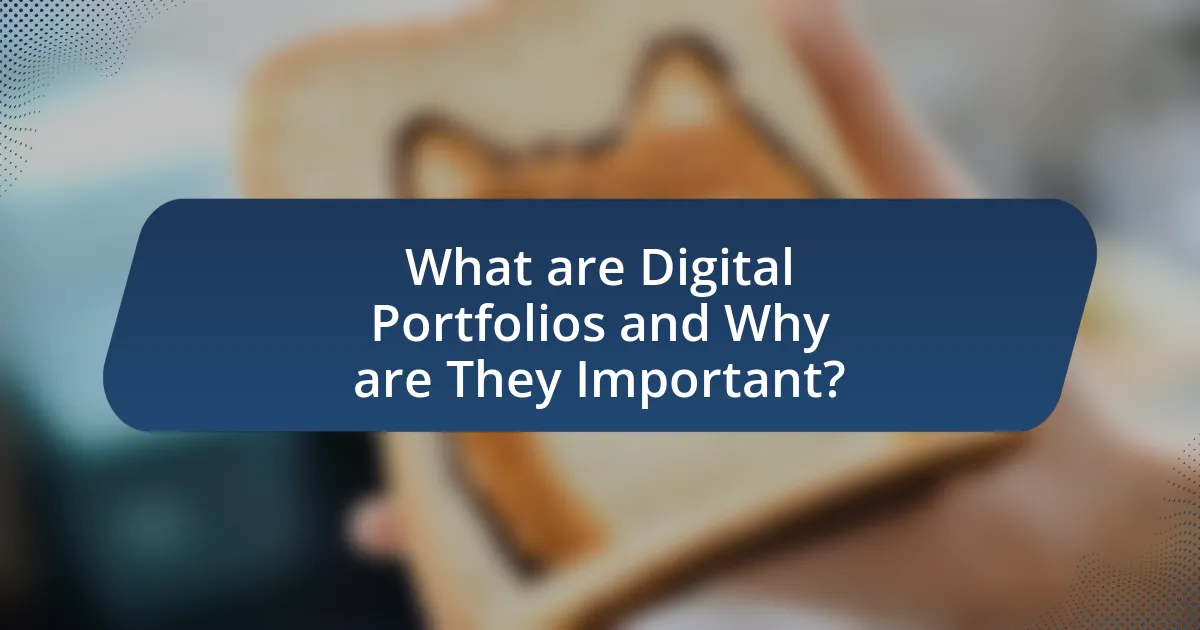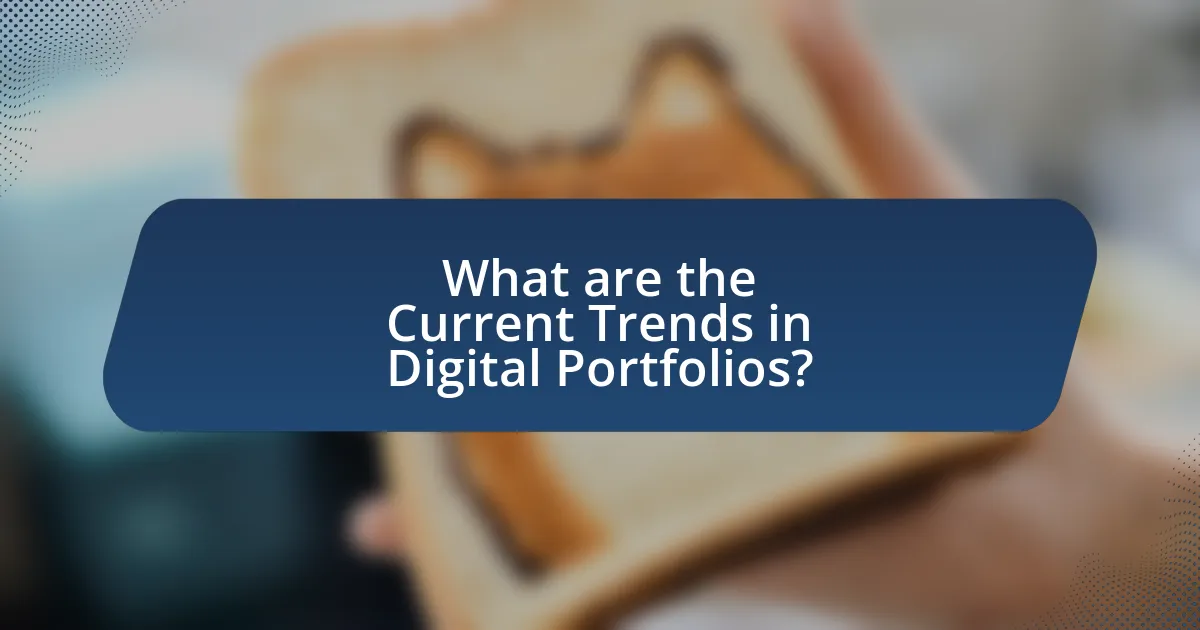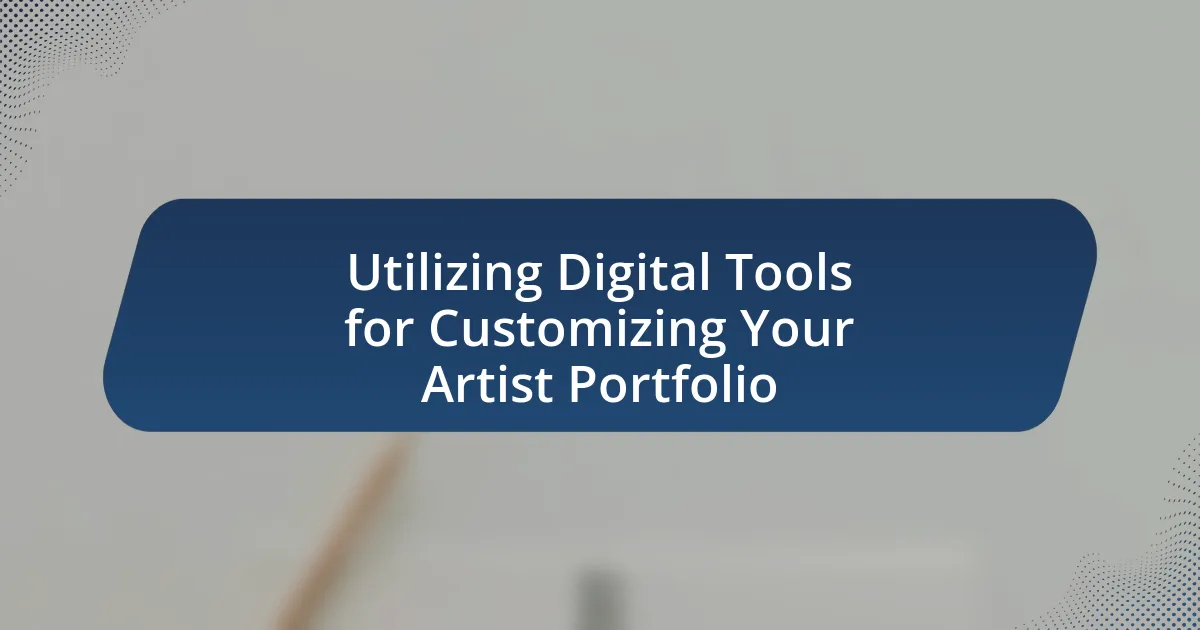Digital portfolios are curated collections of an individual’s work, skills, and achievements presented in a digital format, increasingly preferred by employers for their ability to showcase capabilities beyond traditional resumes. This article explores the significance of digital portfolios in education and career development, highlighting their key features, current trends, and the impact of technology, including artificial intelligence and blockchain, on their evolution. It also discusses best practices for creating effective digital portfolios, emphasizing the importance of multimedia elements, organization, and regular updates to enhance user engagement and marketability in a competitive job landscape.

What are Digital Portfolios and Why are They Important?
Digital portfolios are curated collections of an individual’s work, skills, and achievements presented in a digital format. They are important because they allow individuals to showcase their capabilities to potential employers or educational institutions, facilitating a more comprehensive understanding of their qualifications beyond traditional resumes. Research indicates that 70% of employers prefer candidates with digital portfolios, as these portfolios provide tangible evidence of skills and creativity, enhancing the candidate’s marketability in a competitive job landscape.
How do Digital Portfolios differ from traditional portfolios?
Digital portfolios differ from traditional portfolios primarily in their format and accessibility. Digital portfolios are electronic collections of work that can include multimedia elements such as videos, images, and hyperlinks, allowing for a more dynamic presentation of skills and achievements. In contrast, traditional portfolios are typically physical collections of printed materials, limiting the types of content that can be showcased. Furthermore, digital portfolios can be easily updated and shared online, providing broader access and the ability to reach a wider audience, while traditional portfolios often require physical transportation and can be cumbersome to modify. This shift towards digital formats reflects the increasing reliance on technology in education and professional settings, as evidenced by the growing trend of online job applications and digital showcases in various industries.
What are the key features of Digital Portfolios?
Digital portfolios are characterized by several key features that enhance their functionality and effectiveness. Firstly, they provide a centralized platform for showcasing an individual’s skills, achievements, and experiences through multimedia elements such as text, images, videos, and links. This multimedia capability allows for a richer presentation of work compared to traditional portfolios. Secondly, digital portfolios are easily shareable and accessible, enabling users to distribute their work to a wider audience via email or social media, which increases visibility and networking opportunities.
Additionally, they often include interactive elements, such as hyperlinks and embedded content, which engage viewers and provide a more dynamic experience. Furthermore, digital portfolios can be updated in real-time, allowing users to continuously reflect their latest work and accomplishments without the need for physical revisions. Lastly, many digital portfolio platforms offer analytics features, enabling users to track engagement and understand how their work is being received, which can inform future improvements. These features collectively enhance the utility and appeal of digital portfolios in various professional and educational contexts.
Why is the shift to Digital Portfolios significant in today’s world?
The shift to Digital Portfolios is significant in today’s world because it enhances the way individuals showcase their skills and achievements in a digital format. Digital Portfolios allow for a dynamic presentation of work, integrating multimedia elements such as videos, images, and interactive content, which traditional paper portfolios cannot offer. According to a study by the National Education Association, 85% of educators believe that digital portfolios provide a more comprehensive view of a student’s abilities compared to traditional methods. This shift reflects the increasing importance of digital literacy in the job market, as employers seek candidates who can effectively navigate and utilize technology to present their qualifications.
What role do Digital Portfolios play in education and career development?
Digital portfolios serve as essential tools in education and career development by showcasing an individual’s skills, achievements, and experiences in a structured format. They enable students and professionals to present their work, reflect on their learning, and demonstrate competencies to potential employers or educational institutions. Research indicates that 70% of employers prefer candidates with a digital portfolio, as it provides tangible evidence of skills and creativity, enhancing employability. Furthermore, digital portfolios facilitate personalized learning experiences, allowing users to curate content that aligns with their career goals, thus playing a pivotal role in bridging the gap between education and the workforce.
How do Digital Portfolios enhance learning experiences?
Digital portfolios enhance learning experiences by providing a platform for students to showcase their skills, reflect on their learning, and receive personalized feedback. This interactive tool allows learners to document their progress over time, facilitating self-assessment and goal setting. Research indicates that students who utilize digital portfolios demonstrate improved engagement and motivation, as they take ownership of their learning journey. A study by Barret (2010) highlights that digital portfolios promote deeper learning by encouraging critical thinking and creativity, ultimately leading to better academic outcomes.
In what ways do employers value Digital Portfolios during hiring processes?
Employers value digital portfolios during hiring processes primarily for their ability to showcase a candidate’s skills, experiences, and accomplishments in a visually engaging format. Digital portfolios allow candidates to present work samples, projects, and case studies that demonstrate their competencies, making it easier for employers to assess fit for the role. According to a survey by the National Association of Colleges and Employers, 70% of employers prefer candidates who provide a portfolio, as it offers tangible evidence of skills rather than relying solely on resumes or interviews. This preference highlights the increasing importance of digital portfolios in differentiating candidates in a competitive job market.

What are the Current Trends in Digital Portfolios?
Current trends in digital portfolios include increased integration of multimedia elements, personalization through user-driven content, and the use of data analytics for showcasing skills and achievements. Multimedia elements, such as videos and interactive graphics, enhance engagement and provide a richer representation of an individual’s work. Personalization allows users to tailor their portfolios to specific audiences or job applications, making them more relevant. Additionally, data analytics tools are being utilized to track viewer engagement and optimize content presentation, which helps users understand how their portfolios are perceived. These trends reflect a shift towards more dynamic, user-centered, and data-informed digital portfolio practices.
How is technology shaping the evolution of Digital Portfolios?
Technology is significantly shaping the evolution of digital portfolios by enhancing accessibility, interactivity, and integration with various platforms. The rise of cloud storage solutions allows users to store and share their portfolios easily, while tools like multimedia editing software enable the incorporation of diverse content formats, such as videos and interactive elements. Furthermore, advancements in artificial intelligence and data analytics facilitate personalized learning experiences, allowing users to tailor their portfolios to specific audiences or job markets. For instance, a report by the Educause Review highlights that 70% of institutions are adopting digital portfolio systems to improve student engagement and showcase skills effectively. This integration of technology not only streamlines the creation and management of digital portfolios but also aligns them with current industry standards and expectations.
What tools and platforms are emerging for creating Digital Portfolios?
Emerging tools and platforms for creating digital portfolios include Notion, Wix, and Adobe Portfolio. Notion offers customizable templates and collaborative features, making it suitable for various users, from students to professionals. Wix provides user-friendly website-building capabilities with portfolio-specific templates, allowing for visually appealing presentations. Adobe Portfolio integrates seamlessly with Adobe Creative Cloud, enabling creatives to showcase their work effectively. These platforms are gaining traction due to their ease of use, flexibility, and ability to cater to diverse needs in portfolio creation.
How do mobile applications influence the accessibility of Digital Portfolios?
Mobile applications significantly enhance the accessibility of digital portfolios by allowing users to access, create, and share their portfolios anytime and anywhere. This convenience is facilitated by the widespread use of smartphones and tablets, which enable seamless interaction with digital content. According to a report by Statista, as of 2023, over 6.8 billion smartphone users globally have increased the potential reach of digital portfolios. Furthermore, mobile applications often incorporate features such as offline access, push notifications, and user-friendly interfaces, which further improve user engagement and accessibility. These features collectively ensure that digital portfolios are not only more accessible but also more interactive and dynamic, catering to the needs of diverse users.
What design trends are influencing Digital Portfolios?
Current design trends influencing digital portfolios include minimalism, interactivity, and personalization. Minimalism emphasizes clean layouts and ample white space, allowing content to stand out, which is supported by user preferences for straightforward navigation. Interactivity, such as animations and hover effects, engages users and enhances the overall experience, as evidenced by studies showing increased user retention on interactive sites. Personalization allows users to tailor their portfolios to reflect their unique style and skills, aligning with the growing demand for individualized content in digital spaces. These trends collectively enhance user engagement and improve the effectiveness of digital portfolios in showcasing professional capabilities.
How does user experience (UX) impact the effectiveness of Digital Portfolios?
User experience (UX) significantly impacts the effectiveness of digital portfolios by influencing user engagement and satisfaction. A well-designed UX enhances navigation, making it easier for users to access and interact with content, which can lead to increased retention rates. Research indicates that 88% of online consumers are less likely to return to a site after a bad experience, highlighting the importance of a positive UX in retaining visitors. Furthermore, effective UX design can improve the perceived professionalism of a digital portfolio, which is crucial for job seekers and freelancers aiming to showcase their skills and attract potential employers.
What visual elements are becoming popular in Digital Portfolio designs?
Visual elements becoming popular in digital portfolio designs include minimalistic layouts, bold typography, and interactive features. Minimalistic layouts enhance user experience by focusing on essential content, allowing for easier navigation and engagement. Bold typography captures attention and conveys personality, making portfolios stand out. Interactive features, such as animations and hover effects, create a dynamic experience that encourages exploration. These trends reflect a shift towards user-centric design, emphasizing clarity and engagement in showcasing work effectively.

What Future Developments Can We Expect in Digital Portfolios?
Future developments in digital portfolios will likely include enhanced integration of artificial intelligence and machine learning to personalize user experiences and streamline content curation. These technologies can analyze user data to suggest relevant skills and achievements, making portfolios more dynamic and tailored. Additionally, the rise of blockchain technology may provide secure verification of credentials and accomplishments, increasing trust and authenticity in digital portfolios. According to a report by the World Economic Forum, the demand for digital skills is projected to grow significantly, emphasizing the need for portfolios that can adapt to evolving job market requirements.
How will Artificial Intelligence (AI) impact Digital Portfolios?
Artificial Intelligence (AI) will significantly enhance digital portfolios by automating content curation and personalizing user experiences. AI algorithms can analyze user data to recommend relevant projects, skills, and achievements, making portfolios more tailored and engaging. For instance, platforms like LinkedIn utilize AI to suggest connections and job opportunities based on users’ profiles, demonstrating the effectiveness of AI in enhancing professional visibility. Additionally, AI can streamline the design process by offering templates and layout suggestions that align with current trends, thereby improving the overall aesthetic and functionality of digital portfolios.
What are the potential applications of AI in enhancing Digital Portfolios?
AI can enhance digital portfolios through personalized content curation, automated feedback, and advanced analytics. Personalized content curation allows AI to analyze user preferences and skills, tailoring portfolio elements to showcase relevant work and achievements effectively. Automated feedback systems utilize natural language processing to provide real-time critiques on project presentations, improving the quality of submissions. Advanced analytics enable users to track engagement metrics, such as viewer interactions and time spent on specific portfolio sections, allowing for data-driven improvements. These applications demonstrate AI’s capability to optimize digital portfolios, making them more engaging and effective in showcasing individual talents.
How might AI change the way users curate their Digital Portfolios?
AI will significantly enhance the curation of digital portfolios by automating content organization and personalization. Users can leverage AI algorithms to analyze their work, identify strengths, and suggest optimal arrangements for showcasing skills and experiences. For instance, AI tools can evaluate user data and recommend specific projects or achievements that align with targeted job descriptions, improving relevance and appeal to potential employers. Additionally, AI can facilitate real-time updates and adjustments based on industry trends, ensuring that digital portfolios remain current and competitive. This shift towards AI-driven curation not only saves time but also increases the effectiveness of digital portfolios in representing users’ professional identities.
What are the implications of blockchain technology for Digital Portfolios?
Blockchain technology significantly enhances the security, transparency, and ownership verification of digital portfolios. By utilizing decentralized ledgers, blockchain ensures that all transactions and changes to digital assets are recorded immutably, reducing the risk of fraud and unauthorized alterations. For instance, a study by the World Economic Forum indicates that blockchain can streamline the verification process for credentials and achievements, allowing users to maintain control over their digital identities. This technology also facilitates the creation of smart contracts, which automate and enforce agreements related to digital assets, further increasing efficiency and trust in digital portfolio management.
How can blockchain enhance the security of Digital Portfolios?
Blockchain enhances the security of digital portfolios by providing a decentralized and immutable ledger for transactions. This technology ensures that all transactions are recorded transparently and cannot be altered retroactively, which significantly reduces the risk of fraud and unauthorized access. For instance, a study by the World Economic Forum indicates that blockchain can reduce identity theft and fraud in digital transactions by up to 80%. Additionally, the use of cryptographic techniques in blockchain protects sensitive data, ensuring that only authorized users can access or modify their digital assets. This combination of transparency, immutability, and cryptographic security makes blockchain a robust solution for safeguarding digital portfolios.
What role might blockchain play in verifying credentials within Digital Portfolios?
Blockchain can play a crucial role in verifying credentials within digital portfolios by providing a secure, immutable ledger for storing and sharing educational and professional achievements. This technology ensures that once credentials are recorded, they cannot be altered or forged, thereby enhancing trust among employers and educational institutions. For instance, a study by the World Economic Forum highlights that blockchain can reduce credential fraud by up to 80%, as it allows for real-time verification of qualifications directly from the source. This capability not only streamlines the verification process but also empowers individuals to control their own credentials, fostering a more transparent and efficient system for showcasing skills and accomplishments.
What best practices should users follow when creating Digital Portfolios?
Users should follow several best practices when creating digital portfolios to ensure effectiveness and professionalism. First, they should curate high-quality content that showcases their skills and achievements, as this directly impacts the impression they make on potential employers or clients. Additionally, users should maintain a clean and organized layout, making it easy for viewers to navigate and find relevant information.
Incorporating multimedia elements, such as images, videos, and interactive features, can enhance engagement and provide a more comprehensive view of the user’s work. Regular updates to the portfolio are essential to reflect new skills and experiences, ensuring that the content remains current and relevant.
Furthermore, users should optimize their portfolios for mobile devices, as a significant portion of users access content via smartphones. Lastly, including a personal statement or bio can help convey the user’s unique perspective and professional identity, making the portfolio more relatable and memorable. These practices are supported by research indicating that well-structured and visually appealing portfolios significantly increase the likelihood of attracting attention in competitive job markets.
How can users effectively showcase their skills and experiences in Digital Portfolios?
Users can effectively showcase their skills and experiences in digital portfolios by utilizing a combination of multimedia elements, structured content, and clear organization. Incorporating visuals such as images, videos, and infographics can enhance engagement and provide a more dynamic representation of skills. For instance, a study by the National Association of Colleges and Employers (NACE) found that 70% of employers prefer candidates who present their work visually. Additionally, structuring content with clear headings, concise descriptions, and relevant keywords improves navigability and searchability, making it easier for potential employers to assess qualifications. Furthermore, including specific examples of past projects or achievements, along with measurable outcomes, can substantiate claims and demonstrate real-world impact, reinforcing the portfolio’s effectiveness.
What common mistakes should be avoided when building a Digital Portfolio?
Common mistakes to avoid when building a digital portfolio include neglecting to showcase a diverse range of work, failing to update content regularly, and not tailoring the portfolio to the target audience. Showcasing only a narrow selection of work can limit perceived skills, while outdated content may give the impression of stagnation. Additionally, a portfolio that does not consider the preferences and expectations of the intended audience may fail to engage effectively. These mistakes can hinder the portfolio’s effectiveness in demonstrating capabilities and attracting opportunities.





